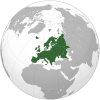फिनल्याण्ड
स्वरूप
Republic of Finland | |
|---|---|
| ढाँचा:Switcher उल्लेखित नक्सा फिनल्याण्ड (dark green) – युरोप महादेश मा (green & dark grey) | |
| राजधानी र सबैभन्दा ठूलो सहर | Helsinki 60°10′N 24°56′E / 60.167°N 24.933°E |
| सबैभन्दा ठूलो शहर | capital |
| आधिकारिक भाषाअन | Finnish • Swedish |
| मान्यता प्राप्त आञ्चलिक भाषाअन | Sámi |
| धर्म | |
| रैथाने(एन) | |
| सरकार | Unitary parliamentary republic[१] |
| Sauli Niinistö | |
| Sanna Marin | |
| व्यवस्थापिका | Eduskunta/Riksdagen |
| Formation | |
| 29 March 1809 | |
| 6 December 1917 | |
| Jan – May 1918 | |
| 1 January 1995 | |
| क्षेत्रफल | |
• जम्मा | 338,424 km2 (130,666 sq mi) (64th) |
• पानि (%) | 10 |
| जनसङ्ख्या | |
• May 2020 लगत | |
• घनत्व | 16/km2 (41.4/sq mi) (213th) |
| कुल ग्राहस्थ उत्पादन (क्रय शक्ति समता) | 2018 लगत |
• जम्मा | $257 billion[३] (60th) |
• प्रति व्यक्ति | $46,559[३] (24th) |
| कुल ग्राहस्थ उत्पादन (साङ्केतिक) | 2018 लगत |
• जम्मा | $277 billion[३] (43rd) |
• प्रति व्यक्ति | $50,068[३] (14th) |
| गिनी (2019) | न्यून · 6th |
| मानव विकास सूचकाङ्क (2018) | भौत उच्च · 12th |
| मुद्रा | Euro (€) (EUR) |
| समय क्षेत्र | अन्तर्राष्ट्रिय प्रमाणिक समय+2 (EET) |
• ग्रीष्मकालिन (दिवाप्रकाश समय बचत) | अन्तर्राष्ट्रिय प्रमाणिक समय+3 (EEST) |
| मिति ढाँचा | d.m.yyyy[६] |
| सडक प्रयोग | right |
| टेलिफोन कोड | +358 |
| आइएसओ ३१६६ सङ्केत | FI |
| इन्टरनेट डोमेन | .fia |
| |
फिनल्याण्ड युरोप महादेशमी रयाको एक देश हो।
यिन लै हेरऽ
[सम्पादन • स्रोत सम्पादन]
सन्दर्भअन
[सम्पादन • स्रोत सम्पादन]- ↑ Formerly a semi-presidential republic, it is now a parliamentary republic according to David Arter, First Chair of Politics at Aberdeen University. In his "Scandinavian Politics Today" (Manchester University Press, revised 2008 ISBN 9780719078538), he quotes Nousiainen, Jaakko (June 2001). "From semi-presidentialism to parliamentary government: political and constitutional developments in Finland". Scandinavian Political Studies. 24 (2): 95–109. doi:10.1111/1467-9477.00048.CS1 maint: ref=harv (link) as follows: "There are hardly any grounds for the epithet 'semi-presidential'." Arter's own conclusions are only slightly more nuanced: "The adoption of a new constitution on 1 March 2000 meant that Finland was no longer a case of semi-presidential government other than in the minimalist sense of a situation where a popularly elected fixed-term president exists alongside a prime minister and cabinet who are responsible to parliament (Elgie 2004: 317)". According to the Finnish Constitution, the president has no possibility to rule the government without the ministerial approval, and does not have the power to dissolve the parliament under his or her own desire. Finland is actually represented by its prime minister, and not by its president, in the Council of the Heads of State and Government of the European Union. The 2012 constitutional amendments reduced the powers of the president even further.
- ↑ "Finland's preliminary population figure 5,528,737 at the end of April". Statistics Finland. Retrieved 1 June 2020.
- ↑ ३.० ३.१ ३.२ ३.३ "Report for Selected Countries and Subjects". IMF. 17 October 2018.
- ↑ "Gini coefficient of equivalised disposable income - EU-SILC survey". ec.europa.eu. Eurostat. Retrieved 27 March 2020.
- ↑ "Human Development Report 2019" (PDF) (in अङ्ग्रेजी). United Nations Development Programme. 10 December 2019. Retrieved 10 December 2019.
- ↑ Ajanilmaukset Archived 2017-10-20 at the Wayback Machine. Kielikello 2/2006. Institute for the Languages of Finland. Retrieved 2017-10-20



